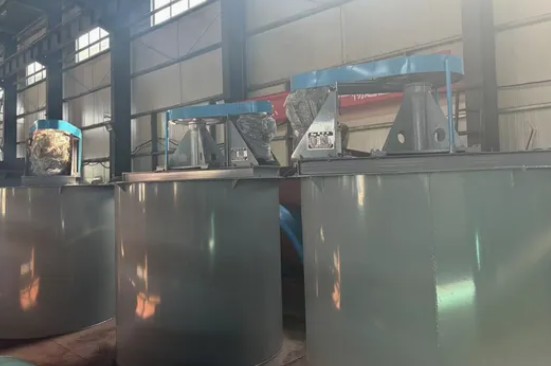NEWS&EVENTS
Home > News&Events > Company news > Efficient application of stirred leaching tank in gold cyanidation purification
As the core reactor of gold cyanide extraction, the design and application optimization of the stirred leaching tank have become the key to improve the gold leaching rate, reduce energy consumption and pollution. This paper focuses on the efficient application of stirred leaching tank in gold cyanide purification, and conducts a systematic analysis from the dimensions of action mechanism, process control and environmental protection practice, aiming to provide the industry with a technical reference that takes into account both efficiency and sustainability.

1. Working principle of stirred leaching tank
The core reaction of gold cyanide extraction is: 4Au + 8CN¯ + O₂ + 2H2O → 4Au(CN)₂+4OH-
The stirred leaching tank uses mechanical or air stirring to enhance the following processes:
(1) Mass transfer efficiency: accelerate the contact between cyanide solution and gold particles.
(2) Oxygen dissolution: increase the dissolved oxygen concentration in the slurry (need to be >6 mg/L).
(3) Uniform reaction: avoid slurry sedimentation and reduce "dead zone".
2. Key factors for efficient application
(1) Agitation intensity: The impeller linear speed is usually 2-4 m/s, and the mixing effect and energy consumption/wear need to be balanced.
(2) Temperature control: The optimal range is 15-30°C. Too high will cause cyanide decomposition (decomposition will accelerate at >35°C).
(3) Cyanide concentration: Optimized to 0.03%-0.1% (needs to be dynamically adjusted according to the properties of the ore).
(4) Slurry concentration: Usually 35-45% solid content. Too high will affect fluidity, and too low will increase costs.
(5) Oxygen supplementation: Maintain dissolved oxygen >6 mg/L through air injection or pure oxygen injection.
3. Process optimization strategy
(1) Multi-stage countercurrent leaching: The first stage has a high cyanide concentration (0.1%) for rapid leaching, and the last stage has a low concentration (0.03%) for extended contact.
(2) Pretreatment enhancement:
Oxidation roasting: Decompose sulfides (such as pyrite) and release encapsulated gold.
Biological pre-oxidation: using acidophilic bacteria to decompose arsenic/sulfur minerals, which is environmentally friendly but has a long cycle.
(3) Automated control: online sensors monitor pH, Eh, and CN⁻ concentrations in real time and dynamically adjust parameters.
4. Environmental protection and safety measures
(1) Cyanide management: closed design + leakage monitoring, workshop hydrogen cyanide concentration <1 ppm.
(2) Tailings treatment:
SO₂-air method: decompose cyanide to <0.2 mg/L.
Natural degradation: light/microorganism-assisted decomposition in the tailings pond.
(3) Waste gas treatment: alkaline solution (NaOH) scrubber absorbs HCN gas.
5. Application cases
Case 1: A large gold mine uses 6 series-connected mechanical stirring tanks (single tank volume 500 m³), and the gold leaching rate is increased from 85% to 93%, and the leaching time is shortened to 24 hours.
Case 2: Pre-oxidation (autoclave oxidation) + cyanidation stirring leaching for difficult-to-treat arsenic gold ore, the recovery rate increased from 40% to 78%.
Through comprehensive optimization of equipment design, process parameters and environmental protection measures, the efficiency of the stirring leaching tank in gold cyanidation purification has been significantly improved, while taking into account both economic efficiency and sustainability.